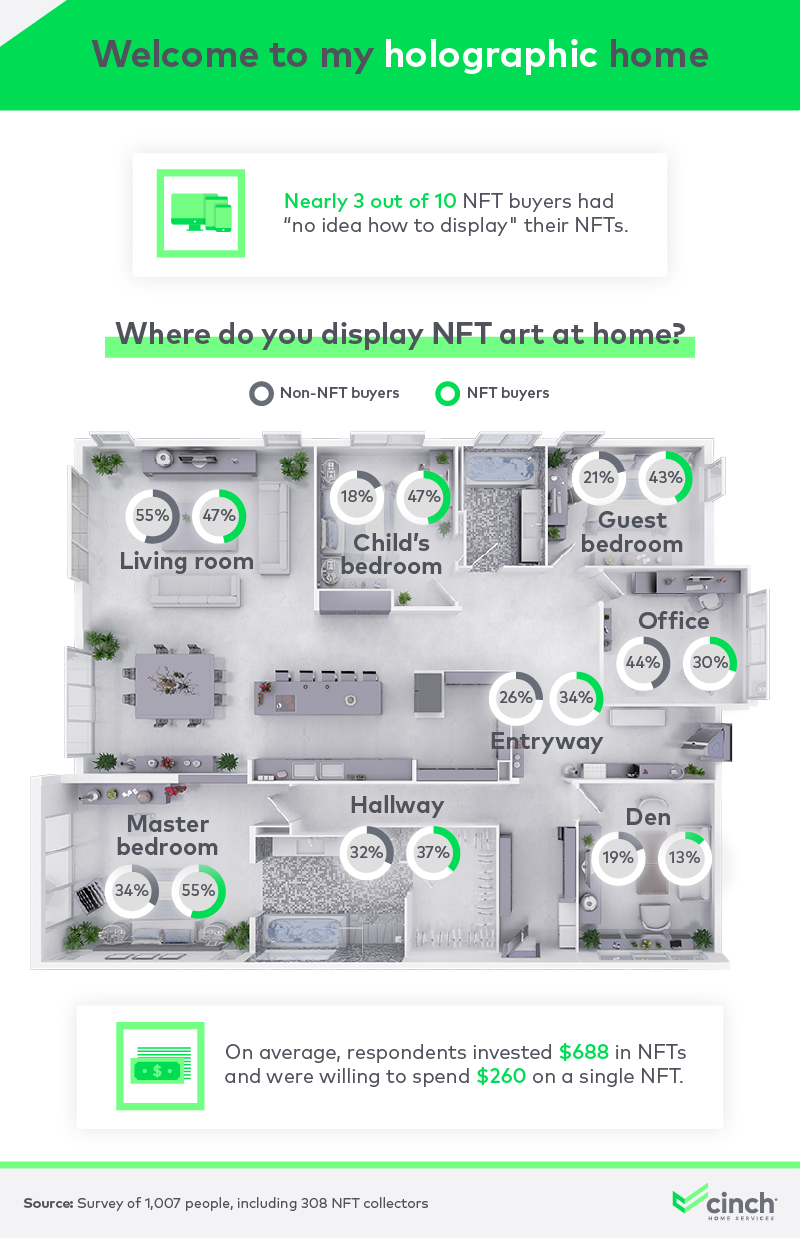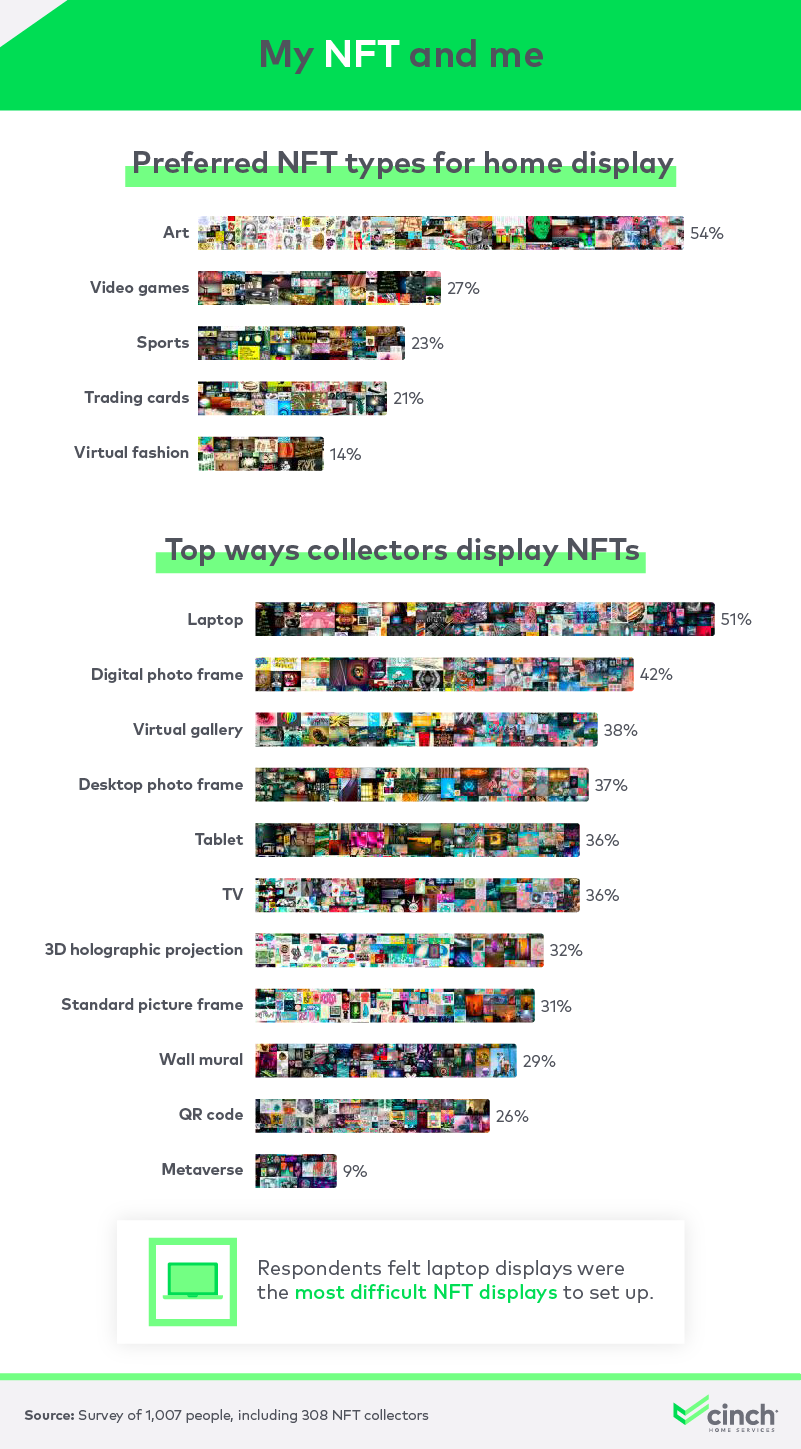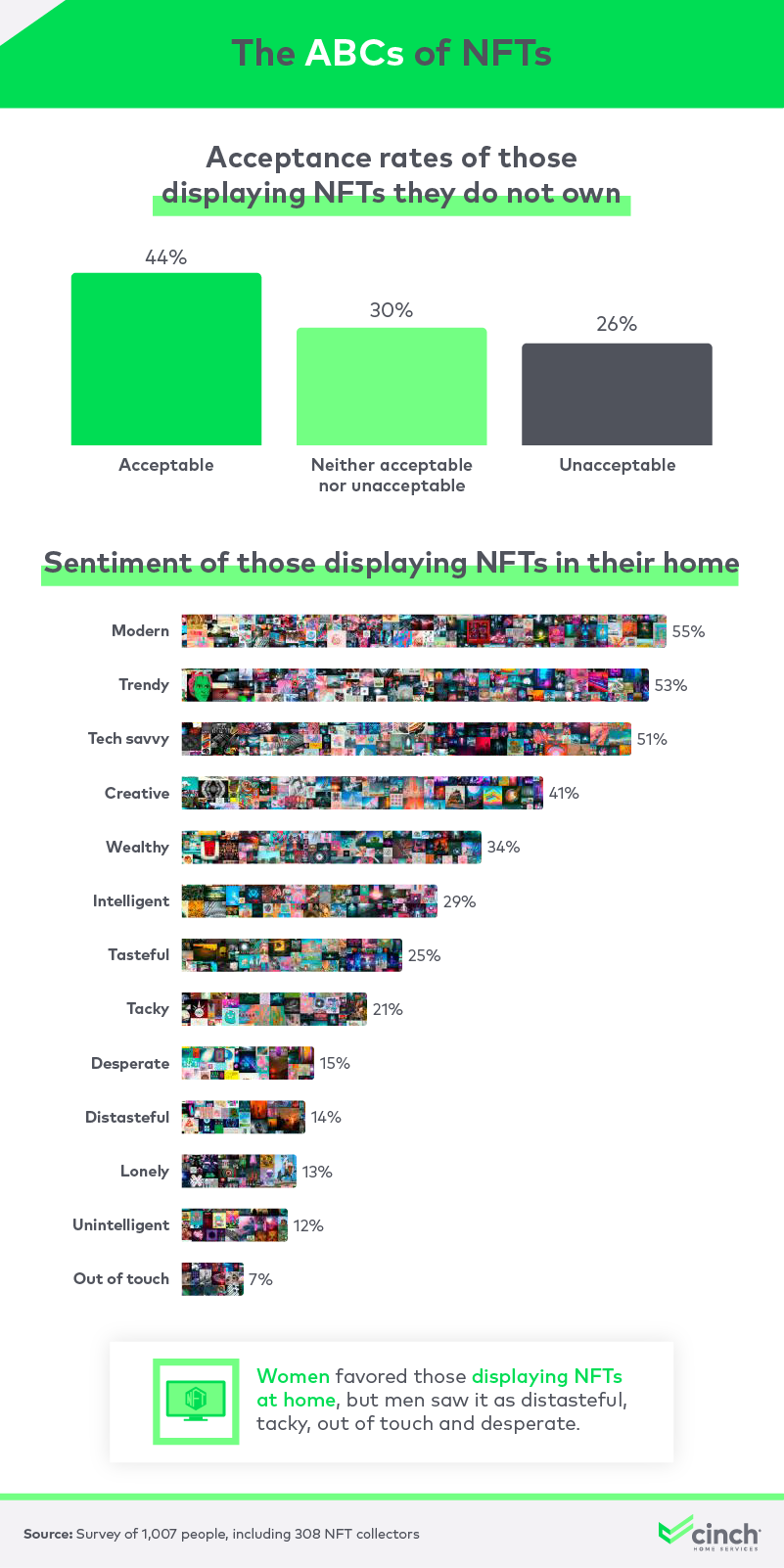While yes, NFTs are technically referring to any and all unique digital assets, they're more commonly understood as digital art, and we at Cinch Home Services want you to think of them that way, especially for our most recent piece of research, where we looked into the ways collectors across the U.S. are physically displaying these digital assets in their homes, as you would a more traditional work of art.
After speaking to a total of 1,007 people living in the U.S.—308 who owned NFTs already and 699 who did not—Cinch now has a clear vision of not only how NFTs are currently being exhibited in the home, but how people perceive their displays. Are people who showcase their NFTs perceived as wealthier? Are certain genders more likely to enjoy the display? And exactly how is a person supposed to mount an NFT on the wall? Keep reading to find out.
How to display digital art in the home
The study began with some fundamental questions. How do respondents display their NFTs? Where in the home did they want them to go? And how much have they already spent on these works of art?

In this early (yet explosive) stage in NFT history, even their owners are confused about how to display their art. NFTs can be displayed in a variety of ways. Some NFTs live in virtual spaces while others live as print-outs similar to traditional art. We asked our survey respondents about how they'd display their NFTs, and nearly three out of every ten buyers had "no idea how to display" their NFTs. Though they had spent an average of $688 on digital asset purchases already, there was rampant confusion as to exactly how to portray those purchases. Nevertheless, buyers did have an idea of where the artwork would go. (We also dig into exact methods of display later in this same study).
Turning the floor to all survey respondents, we next asked where in the home they'd like to see their NFTs "hung." Those who already owned NFTs mostly chose the master bedroom, suggesting a more personal, less public impulse behind the display. They were also commonly interested in displaying the work in their children's room, which may stem from younger generations being more digitally native and inclined. Non-owners, however, opted for perhaps the most public space in the home —the living room.
The best ways to display your NFTs
Displaying digital art doesn't exactly come intuitively. Next, our survey digs into the essential question: which NFTs are you displaying, and how?

Art was the primary type of NFT people were looking to display in their homes, as compared with other non-fungible tokens like video games or sports content. Displaying art has been a natural human inclination since the earliest records of society. NFTs may be shaking a lot of things up, but clearly not this evolutionary instinct.
The most common way people currently display their digital artwork is through their laptops, though many rated this as the most difficult method as well. The laptop has to be kept on as well as active, and inhibits a person from using the laptop for other things. Instead, 42% of people opted to display their NFT art through a dedicated digital frame. Many startups selling exactly that have been thriving as they're often solving the buyer's most difficult question of how to "show off" their newly minted digital assets. These enable the movement and full effect of the NFT to take place, and also don't make you sacrifice your laptop. Plus, they look pretty cool.
Nearly a third said they used standard frames to hang their artwork, presumably after printing it out. While this may seem intuitive and affordable, it may ultimately defeat the purpose of the NFT. Beeple's infamous "Everydays: The First 5000 Days" (which sold for a record-breaking $69M) has inherent value in its ability to be zoomed in upon, as each of the 5,000 smaller pictures within the larger hole has a story to tell. Many other NFTs also move or change, which is not possible through a print out.
Perceptions of NFTs at home
This last piece of our NFT research asked respondents about their perceptions of others displaying NFTs in their homes. Is it widely accepted yet? And what impressions are these in-home NFTs leaving upon visitors?

As of early 2022, displaying NFTs you don’t own is considered mostly acceptable (44%) but not completely. More than one in four people said displaying NFT art you didn’t own is “unacceptable." That said, many Americans have an interest in displaying art they don’t own—either due to budget or access—in the form of fine art prints.
When we asked about specific impressions from displaying NFTs in the home, the vast majority of adjectives that came to mind were positive, especially for women. Women were more likely to perceive the displays as "trendy" or "modern," while men often described the behavior as "tacky" or "distasteful." Historically, women have demonstrated a higher level of interest in the art world compared to men, which may be driving their appreciation of this newer form of art. Once again, it's interesting to see how much NFTs are shaking the art scene, while preserving other traditions.
Showcasing your art your way
Regardless of gender or outsider perceptions, the ability to display art in your home is both a right and a privilege. Many NFT buyers in this study were already doing so, typically choosing the master or children's bedrooms as locations. While respondents often relied on their laptops for the display, the difficulty of doing so made many try digital art frames specifically dedicated to the NFT. And while onlookers ultimately shared mixed emotions on the displays, there are already more than a few fans.
If your home is something you'd like to improve, either through art or even simple upgrades to its more functional assets, Cinch Home Services is always here to help. Whether through research such as this or our core offering of home warranties, Cinch is dedicated to helping your home stay both beautiful and functional. To find the information you need or utilize the help of a home warranty professional, head to our homepage today.
Methodology
We surveyed 1,007 respondents about NFTs and NFT displays in the home. 308 respondents were NFT buyers and 699 were non-buyers. Fifty percent of respondents were men, and 49% were women. One percent of respondents identified as non-conforming. Five percent of respondents were Gen Z, 58% were Millennial, 28% were Gen X, and 10% were Baby Boomers and older.
Survey data has certain limitations related to self-reporting. These limitations include telescoping, exaggeration and selective memory.
Fair Use Statement
NFTs are welcoming novice and experienced investors alike. If you think those with NFT interest are a part of your audience, you are welcome to share these numbers and insights with them. All we request is that you include a link back to this article wherever you choose to share the information.